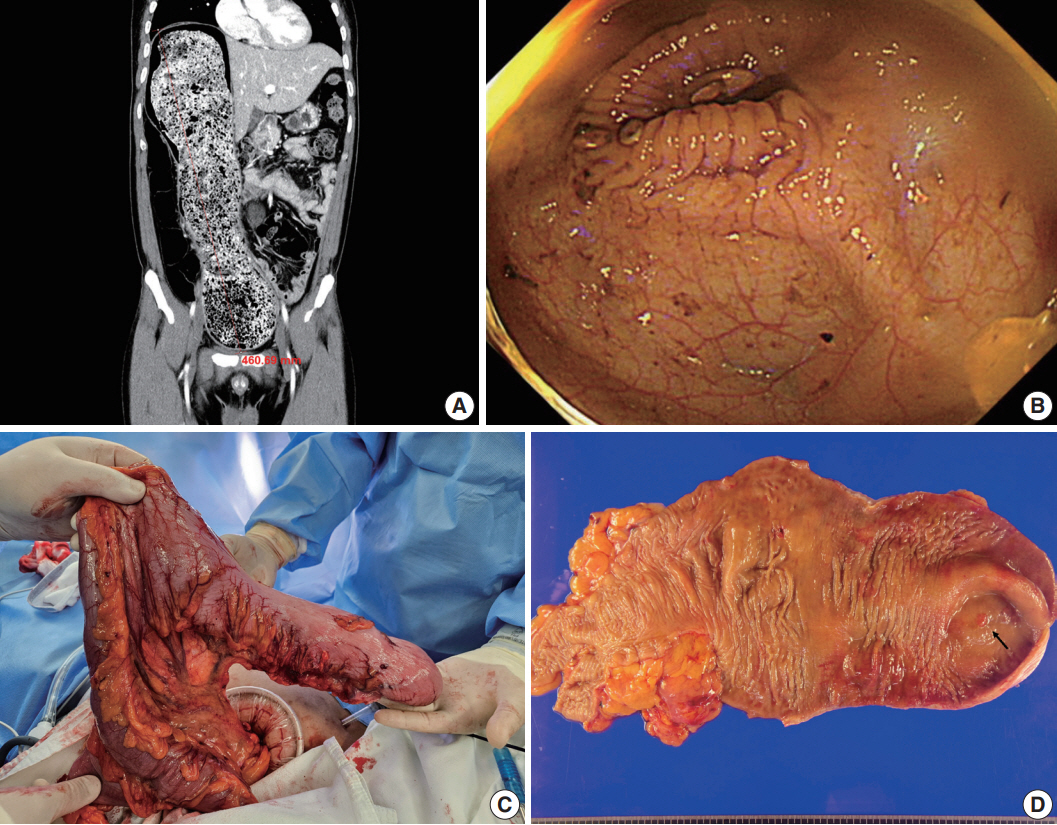J Pathol Transl Med.
2024 Jul;58(4):198-200. 10.4132/jptm.2024.06.04.
Tubular adenoma arising in tubular colonic duplication: a case report
- Affiliations
-
- 1Department of Pathology, Asan Medical Center, University of Ulsan College of Medicine, Seoul, Korea
- 2Division of Colon and Rectal Surgery, Department of Surgery, Asan Medical Center, University of Ulsan College of Medicine, Seoul, Korea
- KMID: 2557760
- DOI: http://doi.org/10.4132/jptm.2024.06.04
Abstract
- Colonic duplication constitutes a rare congenital anomaly, characterized by the presence of hollow cystic or tubular structures exhibiting an epithelial-lined intestinal wall. Diagnostic challenges persist due to its low incidence and manifestation of nonspecific symptoms such as abdominal pain or constipation, resulting in a reluctance to pursue surgical resection. As associated malignancies in colonic duplication are rare, the inherent malignant potential of these anomalies remains undetermined. Additionally, despite reported instances of associated malignancies in colonic duplication, there is an absence of reports in the literature detailing tubular adenoma within these cases. The histologic features of the presented case are particularly noteworthy, situated at the precancerous stage, intimating potential progression towards adenocarcinoma within colonic duplication.
Keyword
Figure
Reference
-
References
1. Schalamon J, Schleef J, Hollwarth ME. Experience with gastro-intestinal duplications in childhood. Langenbecks Arch Surg. 2000; 385:402–5.2. Puligandla PS, Nguyen LT, St-Vil D, et al. Gastrointestinal duplications. J Pediatr Surg. 2003; 38:740–4.3. Fotiadis C, Genetzakis M, Papandreou I, Misiakos EP, Agapitos E, Zografos GC. Colonic duplication in adults: report of two cases presenting with rectal bleeding. World J Gastroenterol. 2005; 11:5072–4.4. Ricciardolo AA, Iaquinta T, Tarantini A, et al. A rare case of acute abdomen in the adult: the intestinal duplication cyst. Case report and review of the literature. Ann Med Surg (Lond). 2019; 40:18–21.5. Orr MM, Edwards AJ. Neoplastic change in duplications of the alimentary tract. Br J Surg. 1975; 62:269–74.6. Kang M, An J, Chung DH, Cho HY. Adenocarcinoma arising in a colonic duplication cyst: a case report and review of the literature. Korean J Pathol. 2014; 48:62–5.7. Jang E, Chung JH. Communicating multiple tubular enteric duplication with toxic megacolon in an infant: a case report. Medicine (Baltimore). 2021; 100:e25772.8. Ryckman FC, Glenn JD, Moazam F. Spontaneous perforation of a colonic duplication. Dis Colon Rectum. 1983; 26:287–9.9. Blank G, Konigsrainer A, Sipos B, Ladurner R. Adenocarcinoma arising in a cystic duplication of the small bowel: case report and review of literature. World J Surg Oncol. 2012; 10:55.
- Full Text Links
- Actions
-
Cited
- CITED
-
- Close
- Share
- Similar articles
-
- Tubular Colonic Duplication Presenting as Rectovestibular Fistula
- A Case of Tubular Duplication of the Esophagus
- A Case of Malignant Transformation of Gastric Tubular Adenoma Proven by 9-year Follow-Up
- A Case of Tubular Esophageal Duplication
- A Case of Papillary Tubular Adenoma (Tubulopapillary Hidradenoma)



